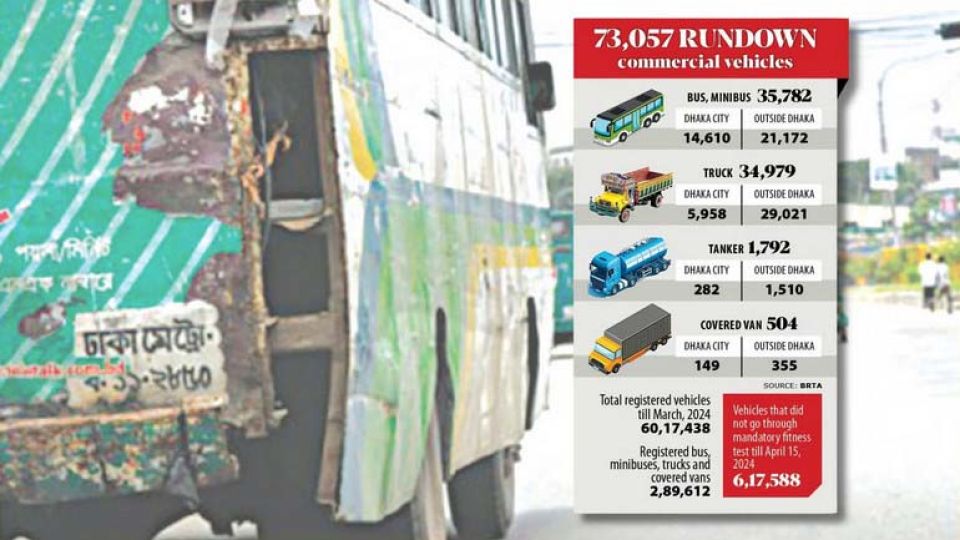April 18, 2024
DHAKA – The bus involved in yesterday’s accident that left 14 dead in Faridpur would not have been on the road had the government not caved in to transport associations’ demand for allowing over 20 years old buses on roads.
The Uttara Unique Paribahan bus was registered in November 2002 and would have been retired if the government last year could stick to its guns on limiting the economic life of buses to 20 years and trucks and lorries to 25 years.
According to the Bangladesh Road Transport Authority (BRTA), there are 35,782 registered buses older than 20 years and 37,275 trucks and lorries over 25 years.
Over 6 lakh registered vehicles, including the Uttara Unique Paribahan bus, did not go through the mandatory annual fitness test.
According to BRTA data, the number of crashes sharply rose this year.
At least 1,477 people were killed, and 1,920 were injured in 1,630 crashes between January and March this year.
In the first three months of 2023, at least 1,051 people were killed and 1,440 were injured in 1,017 crashes.
WHAT EXPERTS SAY
Prof Hadiuzzaman, former director of the Accident Research Institute at Buet, said the maintenance costs of old vehicles increase with time.
Owners often skip maintenance as it cuts into their profits. But they keep the vehicles on the roads jeopardising safety, he told The Daily Star last night.
“The government’s backtracking from setting the economic life was a suicidal move. It will make the road more unsafe,” he said.
He said pressure from transport associations and a lack of proper planning were to blame for the reversal of the government decision.
The government does not have a proper plan to replace the large number of old vehicles with new ones or any strategy to scrap the decades-old vehicles, he added.
Transport expert Prof Shamsul Hoque, however, said a commercial vehicle does not necessarily become unsafe instantly after it exceeds its economic life.
Owners tend not to properly maintain older vehicles as the cost of maintenance increases as the vehicles get older. This makes those vehicles potentially unsafe, he said.
Prof Shamsul, also the director of the Accident Research Centre at Buet, said the environment on roads and the quality of the drivers are more important.
He said lack of intensive monitoring and law enforcement were causing crashes.
“How can a bus operate without a route permit or fitness clearance for such a long time? How can a pickup carry people in broad daylight? What were the highway police and the BRTA doing?”
People got killed due to the failure of those responsible for preventing such illegal activities, he added.
Contacted, BRTA Chairman Nur Mohammad Mazumder said they sent the lists of commercial vehicles beyond their economic life to the environment ministry, transport associations, and the Dhaka Metropolitan Police for taking action.
The BRTA banned buses older than 20 years and trucks older than 25 on Dhaka streets only in 2010.
Asked about the growing number of vehicles without fitness clearance, he said they were going to allow owners until June 30 to have their vehicles tested and certified without paying fines. “We hope this will improve the situation.”
He refuted the allegation of poor monitoring and law enforcement leading to the rise in crashes.
“We have been working hard to prevent speeding on highways over the last few days as speeding is common after Eid when people rush towards Dhaka,” he added.
OLD VEHICLES
After the government set the economic life of commercial vehicles last May, transport associations opposed the decision, saying it would trigger a scarcity of vehicles and spark public unrest before the general elections.
After the poor air quality in the country came to the fore recently, the environment, forest and climate change ministry moved to get old buses off city streets.
During a meeting on March 31, the ministry asked the BRTA for lists of old vehicles and the BRTA sent a list of 73,057 vehicles.
The BRTA believes about 30 percent of all the vehicles registered with it are no longer on the roads.
Meanwhile, the number of registered vehicles without fitness clearance has been rising over the years.
At least 4.79 lakh vehicles did not get their fitness certificates as of July 2019, according to a BRTA report submitted to the High Court.
The number was 5.08 lakh in January 2022 and it rose to 6.17 lakh as of Monday, BRTA sources said.


